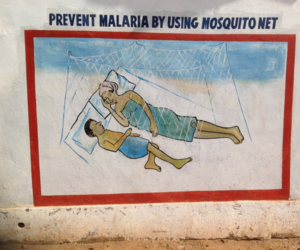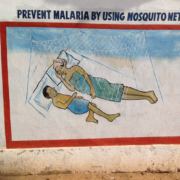New HC3 Study Sheds Light on Ways to Increase Insecticide-treated Net Use in Liberia
Malaria is one of the leading causes of sickness and death in Liberia.

A malaria prevention message on the wall outside Redemption Hospital in Monrovia, Liberia.
© 2016 Sean G. Smith / Critical-Care Professionals International, Courtesy of Photoshare
The most effective means of preventing it is sleeping under a long-lasting insecticide-treated mosquito net (LLIN). LLINs act as a physical barrier between humans and the mosquitoes that spread malaria. Additionally, the insecticide also kills mosquitoes and, when an entire community uses them regularly, there is evidence of some protection to even those not sleeping under a net.
The World Health Organization recommends free mass distribution of LLINs for all community members in countries with high levels of malaria. Liberia has kept up with this recommendation by committing to providing three LLINs for every household in the country. While most Liberians who have access to a net within the household use it, some have not yet picked up the habit.
A study by the Health Communication Capacity Collaborative (HC3) published in the latest version of the journal PLOS ONE, Correlates of Intra-Household ITN Use in Liberia sheds light on ways to increase net use among those with net access.
While access to a net is the most important determinant of use, it is not the only one. HC3 is interested in net ideation, defined as the cognitive, emotional and social reasons people might have for sleeping or not sleeping under LLINs. By understanding how information about a health topic flows through a community, we can learn which social, psychological, skills-based and environmental factors are responsible for some behaviors. For example, a cognitive factor is perceived risk, or, whether or not someone thinks they are likely to get malaria. An emotional factor is self-efficacy, or, whether or not someone thinks they have the ability, or are able, to sleep under a mosquito net. The ideational model of behavior change assumes that many of these factors, working together, influence our intentions and decisions about how to behave.
In 2014, to better understand how to promote LLINs, HC3 attempted to find out what factors were associated with net use in Liberia. A survey was conducted that asked respondents how strongly they agreed or disagreed with a number of statements, and then generated a score (an ideation score) to determine whether this increased or decreased the likelihood that a person would sleep under an LLIN.
Correlates of Intra-Household ITN Use in Liberia is important because it is the first attempt to understand malaria behaviors in Liberia using this theoretical model. The results reveal a great deal of useful information for those involved in social and behavior change communication (SBCC) malaria interventions in Liberia.
- This study found that only about one-third of survey respondents had one or more insecticide treated nets in their household. Far fewer had a net for every sleeping space or one for every two people in the house. The proportion of household members sleeping under a net increased dramatically if the household owned two nets, or three or more nets. This means, first and foremost, that Liberians need more nets.
- Another finding was that female caregiver ideational characteristics were a significant predictor of whether or not nets were being used. If a female caregiver perceived malaria as a severe disease, or felt she was able to recognize signs of severe malaria, members of her household were more likely to have slept under a net. Interestingly, a female caregiver’s perceived susceptibility (whether or not she thinks her family will get malaria) isn’t significantly related to net use. This has been seen in other studies. One explanation is that people sleeping under ITNs feel less likely to get malaria.
- An encouraging finding was that those exposed to malaria prevention messages were twice as likely to sleep under nets.
- Two counties were found to have far fewer nets than the others. This helps planners prioritize these areas in upcoming LLIN distributions.
This study underscores the need for SBCC to prevent and control malaria in Liberia. It also affirmed the need for more LLINs, and provided invaluable information about which factors are associated with net use. This data was recently used in the development of Liberia’s 2016-2020 Malaria Communication Strategy.








Leave a Reply
Want to join the discussion?Feel free to contribute!